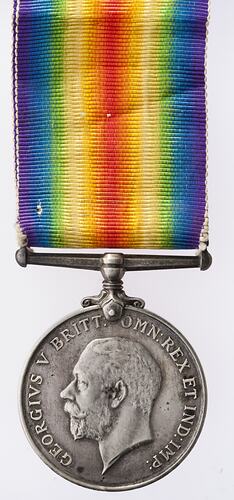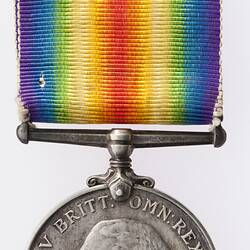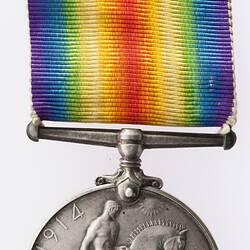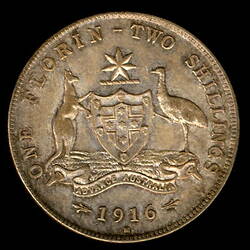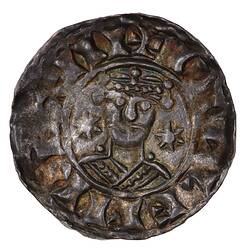Summary
British War Medal 1914-1920 awarded to Pte. William Armstrong Heintz, service number 3011, 6th Battalion, A.I.F.
Private Heintz was born in Hamilton, Victoria. He was a labourer when he joined on 22 September 1915, aged 23 years 8 months. His mother was Josephine Andrews of Port Melbourne, Victoria and later in 1919, was located at Austral Ave, Brunswick. Heintz embarked from Melbourne on 29 September 1915 on HMAT Osterley. He was in Egypt in 1916. By August 1916 he was in France where he suffered from shingles and herpes. He then had trench fever and scabies on 15 December 1917.
Private Heintz was awarded the Military Medal for an operation east of Zonnezbeke, Belgium, 28-30 October 1917. He carried messages through heavy barrages, guided relieving troops to their positions through heavy artillery, and retrieved 2 missing platoons on 9 August 1918. Private Heintz was killed in action in France and is buried at Rosieres, France.
"The British War Medal 1914-1920, authorised in 1919, was awarded to eligible service personnel and civilians alike. Qualification for the award varied slightly according to service. The basic requirement for army personnel and civilians was that they either entered a theatre of war, or rendered approved service overseas between 5 August 1914 and 11 November 1918. Service in Russia in 1919 and 1920 also qualified for the award."
Obverse Description
Bare head of King George V facing left; text around, 'GEORGIVS V BRITT: OMN: REX ET IND: IMP:'; the artist's initials 'B.M.' (Bertram MacKennal) are on the neck truncation.
Reverse Description
Naked figure of St. George on horseback advancing right trampling a shield bearing an eagle design and a skull and crossbone. Above, the sun; in the background, the ocean; text around, '1914 1918'.
Edge Description
Text; '3011 PTE. W.A. HEINTZ. 6 BN. A.I.F.'.
More Information
-
Collection Names
-
Collecting Areas
-
Acquisition Information
Donation from Victorian Branch, Returned & Services League of Australia Limited (RSL), A. Reid, 24 Feb 1986
-
Date Issued
1919 AD
-
Issued By
England, Great Britain, 1914-1920
3011 Pte W.A. Heintz, 6th Battalion, A.I.F. -
Mint
-
Artist
-
Artist
-
Awarded To
Private William A. Heintz, Australia, 1919-1920
3011 Pte W.A. Heintz, 6th Battalion, A.I.F. -
Inscriptions
Obverse; 'GEORGIVS V BRITT: OMN: REX ET IND: IMP:'. 'B.M.' (Bertram MacKennal - artist). Reverse; '1914 1918'. Edge; '3011 PTE. W.A. HEINTZ. 6 BN. A.I.F.'.
-
Material
Silver
-
Axis
12
-
Classification
-
Category
-
Discipline
-
Type of item
-
Overall Dimensions
36 mm (Outside Diameter)
-
Shape
Round with mount and ribbon
-
References
References: National Archives of Australia website - B2455 World War One service records: [Link 1] National Archives UK website: [Link 2]
[Book] Joslin, E C., et al. 1988. British Battles and Medals., 228 - 9 Pages
-
Keywords
